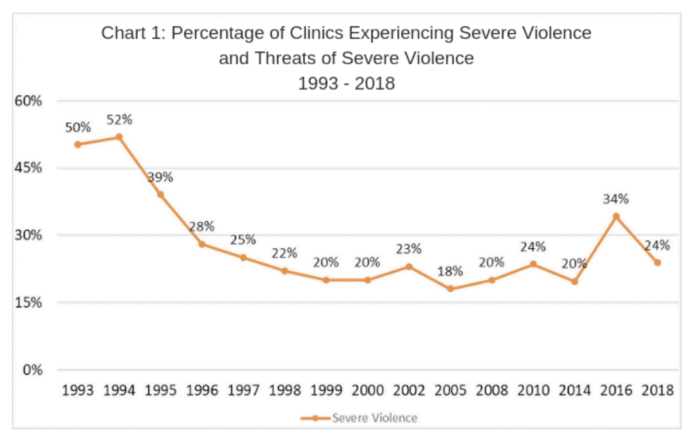
What You Need to Know
Reproductive healthcare providers are the targets of an orchestrated campaign of harassment and intimidation. Feminist student organizations can help by adopting their local reproductive health clinic. Pro-choice mobilization is crucial to reducing anti-abortion violence and harassment. By adopting your local clinic, you will help improve law enforcement response to anti-abortion harassment, bolster the morale of your local clinic and its staff, and bring anti-choice bullies to the attention of your local community. Your grassroots mobilization efforts can and will make a difference!
A Decades-Long Campaign of Terror
Since the 1970s, anti-abortion extremists have used demonstrations, targeted harassment, butyric acid attacks, arson, and death threats in an orchestrated campaign to intimidate abortion providers. Anti-abortion violence turned deadly in the 1990s, claiming the lives of nine people. Dramatic decreases in violence after 1994 were a result of tougher federal and state laws and massive pro-choice organizing to support clinics.
However, anti-abortion leaders vowed to “return to the streets” in the wake of the 2008 presidential election, and on May 31, 2009, abortion provider Dr. George Tiller was murdered by an extremist in Wichita, Kansas. Protests and threats against abortion clinics subsequently increased in Alabama, California, Florida, Kansas, Michigan, Mississippi, Missouri, Nebraska, New Mexico, North Carolina, Ohio, Pennsylvania, Texas, and Virginia.
In 2015, the anti-abortion group Center for Medical Progress began releasing deceptive videos falsely accusing Planned Parenthood of operating an unlawful tissue donation program. These misleading and surreptitiously recorded videos, together with incendiary political rhetoric and actions by state and federal officials, fanned the flames of violence and threats against abortion providers again escalated quickly. Clinics in Maryland, California, Ohio, and several other states reported incidents of serious vandalism, and arsonists set fire to Planned Parenthood locations in Louisiana, California, and Washington. On November 27 that year, an anti-abortion extremist shot and killed three people and wounded nine others at a Planned Parenthood clinic in Colorado Springs, Colorado.

Federal & State Laws Against
Anti-Abortion Violence
In 1994, national abortion rights advocates championed the passage of the Freedom of Access to Clinic Entrances (FACE) Act. The FACE Act created federal civil and criminal penalties for anyone who intentionally uses force or the threat of force to injure, intimidate, or interfere with access to reproductive health services. Since then, California, Connecticut, D.C., Kansas, Maine, Maryland, Minnesota, Nevada, New York, North Carolina, Oregon, Washington, and Wisconsin have enacted tougher state FACE laws to provide greater protection for reproductive health care providers.
Many states, counties, and cities have passed “buffer zone” laws, as well as laws prohibiting residential picketing, to provide clinics with additional protection. Buffer safety zones prohibit anti-abortion protesters from “congregating, picketing, patrolling, demonstrating, or entering” a specific area established around a clinic. Residential picketing laws help keep clinic doctors, staff, and family members safe from intrusive and harassing picketing.
Anti-Abortion Groups & Violence

In Cleveland and Columbus, Ohio; Albuquerque, New Mexico; and Los Angeles, California, extremists have targeted abortion providers at their homes, private offices, clinics, and hospitals with massive posters labeling these physicians as “Killers Among Us.” These materials feature physicians’ names, photographs, home addresses, and other private information—doxxing before doxxing existed. In Louisiana, Florida, and North Carolina, extremists from the national group Operation Rescue/Operation Save America targeted doctors with WANTED-style flyers, and continue to regularly target Mississippi’s last remaining abortion clinic. Some of these extremists include individuals who advocate for what they refer to as “justifiable homicide,” the murder of doctors.
Tactics like these have been used to target doctors who were ultimately murdered, including Dr. Tiller, whose assassin had participated in many Operation Rescue-led actions targeting Dr. Tiller. When the South Wind Women’s Center opened in the building that housed Dr. Tiller’s former practice, Operation Rescue and extremists associated with Tiller’s murderer threatened the new clinic director by distributing WANTED-style flyers and holding signs reading, “WHERE’S YOUR CHURCH?” and “PREPARE TO MEET THY MAKER” outside of her home. Dr. Tiller was murdered in his church.
After his assassination, Operation Rescue began to focus its efforts on doctors that had worked closely with Dr. Tiller in Wichita. Dr. LeRoy Carhart vowed to continue Dr. Tiller’s work and began providing services at a clinic in Germantown, Maryland in addition to his own facility in Nebraska. Immediately, Operation Rescue launched “Keep It Closed” and “Kick Carhart Out of Maryland” campaigns. When two of Dr. Tiller’s former colleagues began providing late abortions in Albuquerque, New Mexico, Operation Rescue teamed up with local anti-abortion extremists to target the Southwestern Women’s Options clinic and the University of New Mexico’s Center for Reproductive Health. Operation Rescue also launched a new website to collect detailed information on doctors, staff, and facilities that provide medication or surgical abortions; some of the providers identified on the site have been stalked by anti-abortion extremists.
